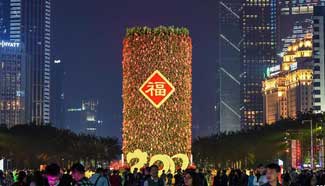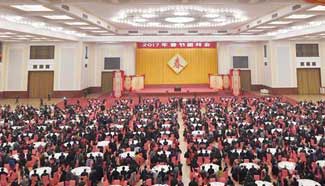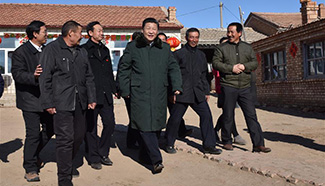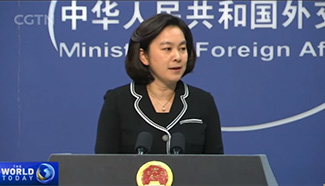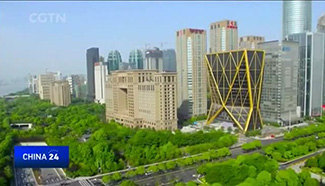By Xinhua writers Liu Wei, Qu Ting and Ding Jing
BEIJING, Jan. 26 (Xinhua) -- At 1:43 a.m., a train pulls out of Beijing Railway Station (BRS), heading to Shangqiu, a small town in central China's Henan Province. Qin Gongquan, 51, slouches in a window seat, relaxing after a long year's toil in the city.
Qin is lucky to have a hard sleeper for his 10-hour journey home, thanks to his daughter who helped book the ticket online.
"Only when they marry will my burdens ease," Qin says of his grown-up children and grins. He grows two crops of rice a year in Shangqiu. In between, he comes to Beijing to work as a mason. Every year, he boards a train in BRS clutching "the cheapest ticket even it means a long journey".
AROUND THE CLOCK
On the day Qin goes home, BRS sees 161 two-way trains take away more than 150,000 passengers. The 40 days of "Chunyun", referring to travel rush around the Chinese Lunar New Year period, sees the world's largest human migration, with about 4.2 million people passing through, arriving at or leaving from BRS.
At 6 a.m., the day's first travel peak begins and 1,500 railway staff are working hard to keep trains on schedule so passengers can have a safe journey.
Liu Wanjun, 56, works all night to make sure passengers have enough hot water. He and his colleagues run water pipes across the tracks day and night during the cold Chunyun. They must take care not to be sucked into the airflow of moving trains.
"A decade ago, there were only 80 to 90 two-way trains," Liu says.
At 8 a.m., a new shift begins and Liu reminds them to eat well before work: "The second travel rush is from 10:30 to 12:30 and the third from 6 p.m. to 9 p.m. - dinner time."
BRS was planned and built in 1959 to mark the 10th anniversary of the founding of the People's Republic of China. Over the years, the facilities have been modernized, but the staff still call different units "che jian", a traditional Chinese name for the BRS teams working in the information, ticketing, operations, repairs, rear service units and others.
Years of operation have created a well-oiled "transportation machine". "Long before Chunyun became a major issue, BRS was operating efficiently with heavy loads," says Xie Jingyi, chairperson of the BRS workers union.
LONGING FOR HOME
At 9:20 p.m., Sun Peng, who works at a seafood store, has been waiting almost 10 hours in a BRS waiting room.
Passengers are crammed into all the waiting rooms. Sun offers his seat to a family and sits by a cooler full of clams, razor shells and oysters. This is for his parents who rarely eat seafood in Qiqihar, a northeastern city about 1,500 kilometers from Beijing. "In our hometown, people rarely see seafood," says Sun.
His train is scheduled to leave the early next morning, and the ice in the box is already melting.
"Many migrant workers are used to waiting a whole day, mainly because they live far from the station and they fear they will miss the train," says Yang Aijin, a conductor for more than 20 years. "However far they are from home, Chinese still want to make it back for Chunyun."
From the 1980s to the mid 1990s, the volume of departing passengers was five times more than BRS was designed for. Pressing crowds at the ticket counter were common before the online ticketing system was launched in 2010.
Yang recalls how BRS opened more than 230 ticket counters at its peak time in 2010, and workers from other posts had to help staff them.
"We sat inside temporary small wooden cabins with only one tiny window. We saw thousands of hands gripping banknotes. Tickets were often sold out within minutes, so people would have to take their luggage and sleep in the plaza overnight for a ticket," Yang says.
This year, ticket-issuing machines are lined up on east and west sides of BRS. As people get used to booking online and collecting tickets from machines, the number of ticket counters has dwindled to about 30.
When Beijing West Railway Station opened in 1996, it alleviated much of the burden, but BRS is still the most important hub for migrant workers from northeast and southern provinces like Anhui, Hunan and Hubei.
"Everyone talks about how the Internet and technology have changed the way people travel, but our service is still tailored for migrant workers who long for home," says Liu Huaqiang, head of BRS business department.
BRS offers services like porters, GPS and facial identification of passengers. The Internet enables passengers to do everything from ticket booking to ordering food. "Manual ticket checks are still open to migrant workers, as they like to hold tickets in their mouths while carrying their luggage with both hands," says Liu. "If the ticket is damp, the ticket check machines will not recognize it."
HISTORIC LANDMARK
As China's oldest working railway station, BRS provides a popular backdrop for tourist photos, with travellers posing before the three gold characters for "Beijing Zhan" written by late Chairman Mao Zedong.
Shen Jia, 33, lives near BRS and often drives past it. "I still keep this family photo. It was in 1990 when my mum, dad and I first embarked on a train and arrived in Beijing. Everyone was excited," Shen recalls.
In the 1990s, trains were the most popular form of long-distance transport in China. "A whole family earned just 70 yuan, while a flight cost 90 yuan - far too much for ordinary people," says Shen.
Qin Gongquan still remembers his excitement and curiosity when he first heard "We are now arriving at Beijing Railway Station" on a train tannoy in 1995. "I elbowed through the crowd and had a close look at the scenery of Beijing," Qin says.
Since its reform and opening up began in 1978, China's economy has soared over three decades, sparking waves of migration.
The year Qin first came to Beijing, China was looking to establish a market economy system. Thousands of migrant workers came to the cities to work on the construction sites. The annual Chunyun migration sees them return home for the holiday.
Administrative barriers and the wealth gap mean many never realize their dreams of fortune.
The government is working to narrow the gap between urban and rural areas, and "to let reform benefit more Chinese people", people like Qin and Sun. A more efficient Chunyun journey is a sign of the changes.
For over 20 years, Qin left Beijing before the hectic peak travel period, but this time "I feel I'm not bothered by the rush anymore," he says. "The convenience of buying tickets and travelling and the personalized service at BRS make it a pleasant trip home."



